
TravelMate 7530/7230 Series
Service Guide
Service guide files and updates are available on the ACER/CSD web; for more information, please refer to http://csd.acer.com.tw
PRINTED IN TAIWAN

TravelMate 7530/7230 Series
Service Guide
Service guide files and updates are available on the ACER/CSD web; for more information, please refer to http://csd.acer.com.tw
PRINTED IN TAIWAN

Revision History
Please refer to the table below for the updates made on TravelMate 7530/7230 Series service guide.
II

Copyright
Copyright ?? 2008 by Acer Incorporated. All rights reserved. No part of this publication may be reproduced, transmitted, transcribed, stored in a retrieval system, or translated into any language or computer language, in any form or by any means, electronic, mechanical, magnetic, optical, chemical, manual or otherwise, without the prior written permission of Acer Incorporated.
Disclaimer
The information in this guide is subject to change without notice.
Acer Incorporated makes no representations or warranties, either expressed or implied, with respect to the contents hereof and specifically disclaims any warranties of merchantability or fitness for any particular purpose. Any Acer Incorporated software described in this manual is sold or licensed "as is". Should the programs prove defective following their purchase, the buyer (and not Acer Incorporated, its distributor, or its dealer) assumes the entire cost of all necessary servicing, repair, and any incidental or consequential damages resulting from any defect in the software.
Acer is a registered trademark of Acer Corporation. Intel is a registered trademark of Intel Corporation.
Pentium and Pentium II/III are trademarks of Intel Corporation.
Other brand and product names are trademarks and/or registered trademarks of their respective holders.
III

Conventions
The following conventions are used in this manual:
IV

Preface
Before using this information and the product it supports, please read the following general information.
1.This Service Guide provides you with all technical information relating to the BASIC CONFIGURATION decided for Acer's "global" product offering. To better fit local market requirements and enhance product competitiveness, your regional office MAY have decided to extend the functionality of a machine (e.g.
2.Please note WHEN ORDERING FRU PARTS, that you should check the most
V

VI

Table of Contents
Features . . . . . . . . . . . . . . . . . . . . . . . . . . . . . . . . . . . . . . . . . . . . . . . . . . . . . . . . . . . .1 System Block Diagram . . . . . . . . . . . . . . . . . . . . . . . . . . . . . . . . . . . . . . . . . . . . . . . . .4 Your Acer Notebook tour . . . . . . . . . . . . . . . . . . . . . . . . . . . . . . . . . . . . . . . . . . . . . . .5 Front View . . . . . . . . . . . . . . . . . . . . . . . . . . . . . . . . . . . . . . . . . . . . . . . . . . . . . . .5 Closed Front View . . . . . . . . . . . . . . . . . . . . . . . . . . . . . . . . . . . . . . . . . . . . . . . . .6 Left View . . . . . . . . . . . . . . . . . . . . . . . . . . . . . . . . . . . . . . . . . . . . . . . . . . . . . . . .7 Right View . . . . . . . . . . . . . . . . . . . . . . . . . . . . . . . . . . . . . . . . . . . . . . . . . . . . . . .8 Rear View . . . . . . . . . . . . . . . . . . . . . . . . . . . . . . . . . . . . . . . . . . . . . . . . . . . . . . .8 Bottom View . . . . . . . . . . . . . . . . . . . . . . . . . . . . . . . . . . . . . . . . . . . . . . . . . . . . .9 Indicators . . . . . . . . . . . . . . . . . . . . . . . . . . . . . . . . . . . . . . . . . . . . . . . . . . . . . .10
Using the System Utilities . . . . . . . . . . . . . . . . . . . . . . . . . . . . . . . . . . . . . . . . . . . . . .16 Acer GridVista
VII

VIII

Table of Contents
IX

Table of Contents
X

Chapter 1
System Specifications
Features
Below is a brief summary of the computer???s many feature:
NOTE: Items marked with * denote only selected models.
Operating System
???Genuine Windows?? Vista???
Platform
???AMD Better by Design program, featuring:
???AMD Turion??? X2
???AMD Athlon??? X2
???Mobile AMD Sempron??? processor (TravelMate 7230 only)
???AMD RS780MN/SB700 Chipset
???Acer InviLink??? 802.11b/g
System Memory
???
???Up to 2 GB of DDR2 667 MHz memory, upgradeable to 4 GB using two soDIMM modules*
Display and graphics
???17" WXGA+ 1440 x 900
???ATI Radeon??? HD 3200 Graphics*
???ATI Mobility Radeon??? HD 3470 Hybrid x 2*
Storage subsystem
???2.5" hard disk drive
???Optical drive options:
???
???
???
???
Audio
???Two
???
???
???

Communication
???Acer Video Conference, featuring:
???Integrated Acer Crystal Eye webcam*
???Optional Acer Xpress VoIP phone*
???WLAN: Acer InviLink??? 802.11b/g
???WPAN: Bluetooth?? 2.0+Enhanced Data Rate (EDR)*
???LAN: Gigabit Ethernet,
???Modem: 56K ITU V.92
Privacy control
???Enhanced Acer DASP (Disk
?????? Acer
?????? BIOS user, supervisor, HDD passwords
?????? Kensington lock slot
Dimensions
???396 (W) x 286 (D) x 35.2/44 (H) mm (15.59 x 11.261 x 1.39/1.73 inches)
???3.60 kg (7.93 lbs.) with 2 HDDs and
???3.40 kg (7.48 lbs.) with one HDD and
Power subsystem
???ACPI 3.0
???71 W 4800 mAh*
???48.8W 4400 mAh*
???
???
???Energy Star 4.0
Input Devices
???
???Touchpad pointing device
I/O interface
???Acer EasyPort IV connector
???ExpressCard???/54 slot
???PC Card slot (Type II)
???Acer
???
???Four USB 2.0 ports
???HDMI??? port with HDCP support*
???External display (VGA) port

???
???
???
???Ethernet
???Modem
???
Environment
???Temperature:
???Operating: 5 ??C to 35 ??C (41??F to 95??F)
???
???Humidity
???Operating: 20% to 80%
???
NOTE: Items marked with * denote only selected models.
NOTE: The specifications listed above are for reference only. The exact configuration of your PC depends on the model purchased.

System Block Diagram

Your Acer Notebook tour
After knowing your computer features, let us show you around your new computer.
Front View

Closed Front View

Left View

Right View
Rear View

Bottom View

Indicators
The computer has several
NOTE: 1. Charging: The light shows amber when the battery is charging. 2. Fully charged: The light shows green when in AC mode.
Located beside the keyboard are application buttons. These buttons are called
The mail and Web browser buttons are

Productivity Keys (only for certain models)
Three productivity keys give users
???Lock key - runs the Windows?? lock function to lock the notebook when you step out. If the laptop is equipped with Acer
???Presentation key - minimizes open application windows and prepares the display for impressive presentations.
???Sync key - instantly synchronizes your computer system to an external storage device, for convenient and secure backup.

TouchPad Basics (with fingerprint reader)
The following items show you how to use the TouchPad with Acer
???Move your finger across the touchpad (1) to move the cursor.
???Press the left (2) and right (4) buttons located beneath the touchpad to perform selection and execution functions. These two buttons are similar to the left and right buttons on a mouse. Tapping on the touchpad is the same as clicking the left button.
???Use Acer
NOTE: When using the TouchPad, keep it - and your fingers - dry and clean. The TouchPad is sensitive to finger movement; hence, the lighter the touch, the better the response. Tapping too hard will not increase the TouchPad???s responsiveness.

Using the Keyboard
The keyboard has
Lock Keys and embedded numeric keypad
The keyboard has three lock keys which you can toggle on and off.
The embedded numeric keypad functions like a desktop numeric keypad. It is indicated by small characters located on the upper right corner of the keycaps. To simplify the keyboard legend,

Windows Keys
The keyboard has two keys that perform

Hot Keys
The computer employs hotkeys or key combinations to access most of the computer???s controls like screen brightness, volume output and the BIOS utility.
To activate hot keys, press and hold the <Fn> key before pressing the other key in the hotkey combination.
Special Key (only for certain models)
You can locate the Euro symbol and the US dollar sign at the
The Euro symbol
1.Open a text editor or word processor.
2.Press ??? at the
NOTE: Some fonts and software do not support the Euro symbol. Please refer to www.microsoft.com/ typography/faq/faq12.htm for more information.
The US dollar sign
1.Open a text editor or word processor.
2.Press $ at the
NOTE: This function varies by the operating system version.

Using the System Utilities
Acer
Acer
For more information refer to the Acer
Acer GridVista
NOTE: This feature is only available on certain models.
To enable the dual monitor feature of the notebook, first ensure that the second monitor is connected, then select Start, Control Panel, Display and click on Settings. Select the secondary monitor (2) icon in the display box and then click the check box Extend my windows desktop onto this monitor. Finally, click Apply to confirm the new settings and click OK to complete the process.
Acer GridVista is a handy utility that offers four

Double (vertical), Triple (primary at left), Triple (primary at right), or Quad Acer Gridvista is
Acer Gridvista is
1.Run Acer GridVista and select your preferred screen configuration for each display from the task bar.
2.Drag and drop each window into the appropriate grid.
3.Enjoy the convenience of a
NOTE: Please ensure that the resolution setting of the second monitor is set to the manufacturer's recommended value.

Hardware Specifications and Configurations
Processor

South Bridge
???Throttling 50%: On = 97??C; Off = 88??C
???OS Shut down: 105??C
???H/W Shut down: 110??C
???Fan default 3.5V
System Clock

Crystal and Oscillator

Hard Disk Drive Interface
Item
Vendor &
Model
Name
Capacity (MB)
Bytes per sector
Data heads
Drive Format
Disks
Spindle speed (RPM)
Performance Specifications
Buffer size
Interface
Max. media transfer rate (disk- buffer, Mbytes/s)
Data transfer rate (host~buffe r, Mbytes/s)
DC Power Requirements
Voltage tolerance
Combo Drive Module

BIOS

VGA Subsystem

LAN Interface



Chapter 2
System Utilities
BIOS Setup Utility
The BIOS Setup Utility is a hardware configuration program built into your computer???s BIOS (Basic Input/ Output System).
Your computer is already properly configured and optimized, and you do not need to run this utility. However, if you encounter configuration problems, you may need to run Setup. Please also refer to Chapter 4 Troubleshooting when problem arises.
To activate the BIOS Utility, press F2 during POST (when ???Press <F2> to enter Setup??? message is prompted on the bottom of screen).
Press F2 to enter setup. The default parameter of F12 Boot Menu is set to ???disabled???. If you want to change boot device without entering BIOS Setup Utility, please set the parameter to ???enabled???.
Press <F12> during POST to enter
Navigating the BIOS Utility
There are six menu options: Information, Main, Advanced, Security, Boot, and Exit.
Follow these instructions:
???To choose a menu, use the left and right arrow keys.
???To choose an item, use the up and down arrow keys.
???To change the value of a parameter, press F5 or F6.
???A plus sign (+) indicates the item has
???Press Esc while you are in any of the menu options to go to the Exit menu.
???In any menu, you can load default settings by pressing F9. You can also press F10 to save any changes made and exit the BIOS Setup Utility.
NOTE: You can change the value of a parameter if it is enclosed in square brackets. Navigation keys for a particular menu are shown on the bottom of the screen. Help for parameters are found in the Item Specific Help part of the screen. Read this carefully when making changes to parameter values. Please note that system information is subject to different models.

Information
The Information screen displays a summary of your computer hardware information.
NOTE: The system information is subject to different models.

Main
The Main screen allows the user to set the system time and date as well as enable and disable boot option and recovery.
NOTE: The screen above is for your reference only. Actual values may differ.
The table below describes the parameters in this screen. Settings in boldface are the default and suggested parameter settings.

Advanced
The Advanced screen allows the user to configure the various advanced BIOS options.
IMPORTANT:Making incorrect settings to items on these pages may cause the system to malfunction. Unless you have experience adjusting these items, we recommend that you leave these settings at the default values. If making settings to items on these pages causes your system to malfunction or prevents the system from booting, open BIOS and choose Load Optimal Defaults in the Exit menu to boot up normally.
The table below describes the items, menus, and submenus in this screen. Settings in boldface are the default and suggested parameter settings.



Security
The Security screen contains parameters that help safeguard and protect your computer from unauthorized use.
The table below describes the parameters in this screen. Settings in boldface are the default and suggested parameter settings.
NOTE: When you are prompted to enter a password, you have three tries before the system halts. Don???t forget your password. If you forget your password, you may have to return your notebook computer to your dealer to reset it.
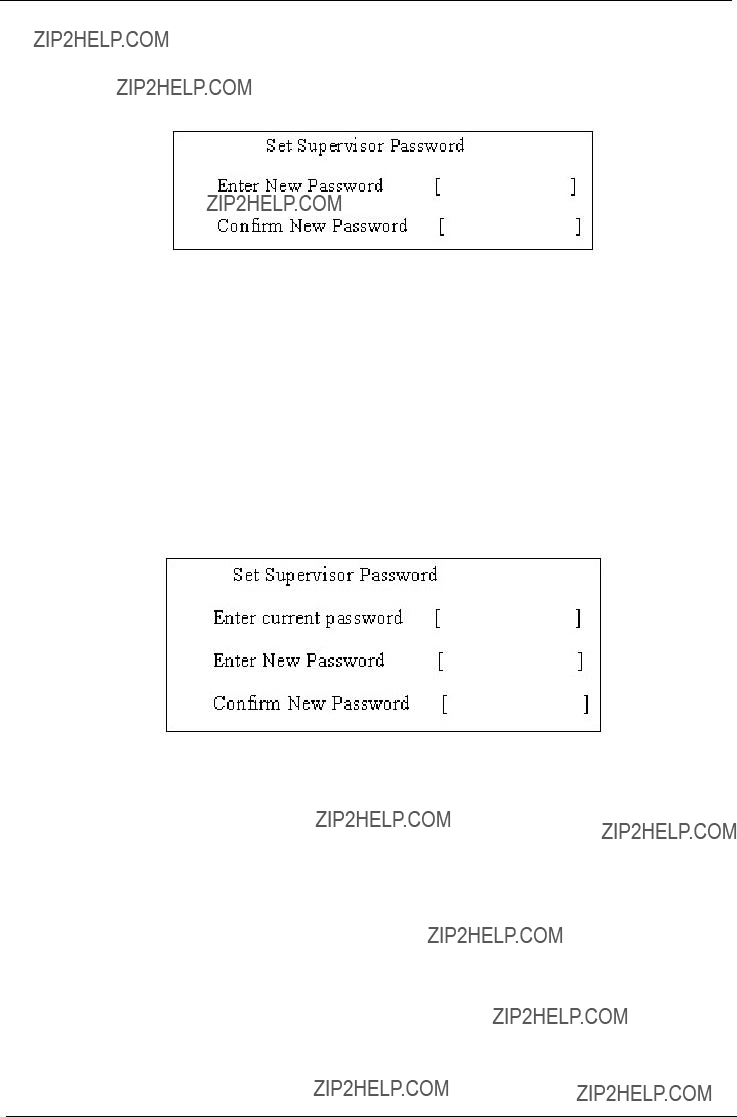
Setting a Password
Follow these steps as you set the user or the supervisor password:
1.Use the ??? and ??? keys to highlight the Set Supervisor Password parameter and press the Enter key. The Set Supervisor Password box appears:
2.Type a password in the ???Enter New Password??? field. The password length can not exceeds 8 alphanumeric characters
IMPORTANT:Be very careful when typing your password because the characters do not appear on the screen.
3.Press Enter. After setting the password, the computer sets the User Password parameter to ???Set???.
4.If desired, you can opt to enable the Password on boot parameter.
5.When you are done, press F10 to save the changes and exit the BIOS Setup Utility.
Removing a Password
Follow these steps:
1.Use the w and y keys to highlight the Set Supervisor Password parameter and press the Enter key. The Set Password box appears:
2.Type the current password in the Enter Current Password field and press Enter.
3.Press e twice without typing anything in the Enter New Password and Confirm New Password fields. The computer then sets the Supervisor Password parameter to ???Clear???.
4.When you have changed the settings, press u to save the changes and exit the BIOS Setup Utility.

Changing a Password
1.Use the ??? and ??? keys to highlight the Set Supervisor Password parameter and press the Enter key. The Set Password box appears.
2.Type the current password in the Enter Current Password field and press Enter.
3.Type a password in the Enter New Password field. Retype the password in the Confirm New Password field.
4.Press Enter. After setting the password, the computer sets the User Password parameter to ???Set???.
5.If desired, you can enable the Password on boot parameter.
6.When you are done, press F10 to save the changes and exit the BIOS Setup Utility.
If the verification is OK, the screen will display as following.
The password setting is complete after the user presses Enter.
If the current password entered does not match the actual current password, the screen will show you the Setup Warning.
If the new password and confirm new password strings do not match, the screen will display the following message.

Boot
This menu allows the user to decide the order of boot devices to load the operating system. Bootable devices includes the USB diskette drives, the onboard hard disk drive and the DVD drive in the module bay.

Power
The Power screen allows the user to configure various CPU and power management options and device wakeup behavior.
The table below describes the items, menus, and submenus in this screen. Settings in boldface are the default and suggested parameter settings.


Exit
The Exit screen allows you to save or discard any changes you made and quit the BIOS Utility.

BIOS Flash Utility
The BIOS flash memory update is required for the following conditions:
???New versions of system programs
???New features or options
???Restore a BIOS when it becomes corrupted. Use the Phlash utility to update the system BIOS flash ROM.
NOTE: If you do not have a crisis recovery diskette at hand, then you should create a Crisis Recovery Diskette before you use the Phlash utility.
NOTE: Do not install
NOTE: Please use the AC adaptor power supply when you run the Phlash utility. If the battery pack does not contain enough power to finish BIOS flash, you may not boot the system because the BIOS is not completely loaded.
Fellow the steps below to run the Phlash.
1.Prepare a bootable diskette.
2.Copy the flash utilities to the bootable diskette.
3.Then boot the system from the bootable diskette. The flash utility has

Remove HDD/BIOS Utility
This section provide you with removing HDD/BIOS method:
Remove HDD Password:
???If you key in wrong HDD password for three time, ???HDD password error code??? would display on the screen. See the image below.
??? If you need to solve HDD password locked problem, you can run HDD_PW.EXE
1.Key in ???hdd_pw 15494 0???
2.Select ???2???
3.Choose one
???Reboot system and key in ???0KJFN42??? or ???UVEIQ96??? to HDD user password.


Remove BIOS Password:
???If you key in wrong Supervisor Password for three time, ???System Disabled??? would display on the screen. See the image below.
??? If you need to solve BIOS password locked problem, you can run BIOS_PW.EXE
1.Key in ???bios_pw 14452 0???
2.Choose one
???Reboot the system and key in ???qjjg9vy??? or ???07yqmjd??? to BIOS user password.


Chapter 3
Machine Disassembly and Replacement
This chapter contains
Disassembly Requirements
To disassemble the computer, you need the following tools:
???Wrist grounding strap and conductive mat for preventing electrostatic discharge
???Flat screwdriver
???Philips screwdriver
???Plastic flat screwdriver
???Plastic tweezers
NOTE: The screws for the different components vary in size. During the disassembly process, group the screws with the corresponding components to avoid mismatch when putting back the components.

General Information
Before proceeding with the disassembly procedure, make sure that you do the following:
1.Turn off the power to the system and all peripherals.
2.Unplug the AC adapter and all power and signal cables from the system.
3.Place the system on a flat, stable surface.
4.Remove the battery pack.
Disassembly Process
The disassembly process is divided into the following stages:
???External module disassembly
???Main unit disassembly
???LCD module disassembly
The flowcharts provided in the succeeding disassembly sections illustrate the entire disassembly sequence. Observe the order of the sequence to avoid damage to any of the hardware components. For example, if you want to remove the main board, you must first remove the keyboard, then disassemble the inside assembly frame in that order.
Main Screw List

External Module Disassembly Process
External Modules Disassembly Flowchart
The flowchart below gives you a graphic representation on the entire disassembly sequence and instructs you on the components that need to be removed during servicing. For example, if you want to remove the main board, you must first remove the keyboard, then disassemble the inside assembly frame in that order.
Remove
Lower Covers

Removing the Battery Pack
1.Turn computer over.
2.Slide the battery lock/unlock latch to the unlock position.
3.Slide and hold the battery release latch to the release position (1), then slide out the battery pack from the main unit (2).
 2
2
 1
1

Removing the SD dummy card
1. Push the SD dummy card all the way in to eject it.
2. Pull it out from the slot.

Removing the ExpressCard dummy card
1. Push the ExpressCard dummy card all the way in to eject it.
2. Pull it out from the slot.

Removing the Lower Covers
1.See ???Removing the Battery Pack??? on page 48.
2.See ???Removing the SD dummy card??? on page 49.
3.See ???Removing the ExpressCard dummy card??? on page 50.
4.Loosen the 9 captive screws on the HDD1, HDD2, and Memory covers.
Memory
Cover
5. Carefully open the memory cover.

6. Remove the HDD2 cover as shown.
7. Remove the HDD1 cover as shown.
Removing the Turbo RAM module
1.See ???Removing the Battery Pack??? on page 48.
2.Remove the HDD2 cover. See ???Removing the Lower Covers??? on page 51.
3.Remove the Turbo RAM module as shown.

Removing the WLAN Module
1.See ???Removing the Turbo RAM module??? on page 52.
2.Disconnect the 3 antenna cables from the WLAN board.
3. Move the antenna cables away and remove the two screws on the WLAN board to release the WLAN board.
4. Detach the WLAN board from the WLAN socket.

Removing the Hard Disk Drive2 Module
1.See ???Removing the Battery Pack??? on page 48.
2.Remove the HDD2 cover. See ???Removing the Lower Covers??? on page 51.
3.Use the
NOTE: To prevent damage to device, avoid pressing down on it or placing heavy objects on top of it.
4. Remove the HDD2 holder by easing the sides outward to clear the carrier.

5. Remove the four screws securing the hard disk to the carrier.
6. Remove the HDD from the carrier.
7. Remove the connector from the HDD.

Removing the Hard Disk Drive1 Module
1.See ???Removing the Battery Pack??? on page 48.
2.Remove the HDD1 cover. See ???Removing the Lower Covers??? on page 51.
3.Use the
NOTE: To prevent damage to device, avoid pressing down on it or placing heavy objects on top of it.
4. Remove the HDD1 holder by easing the sides outward to clear the carrier.
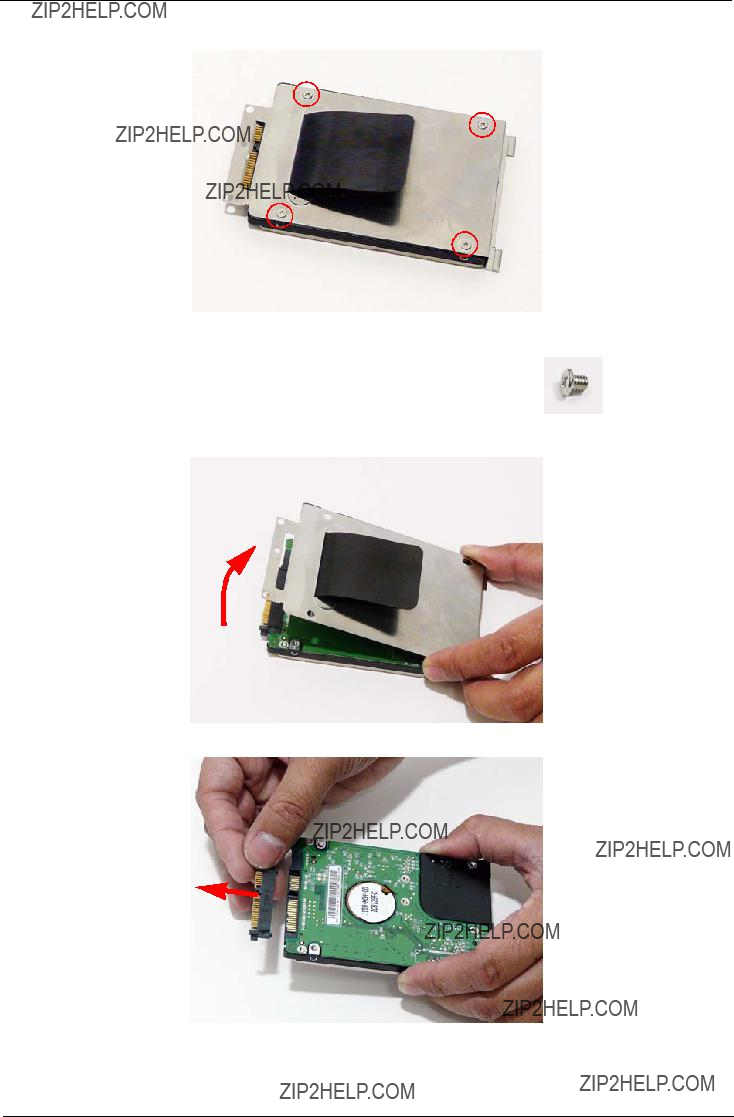
5. Remove the four screws securing the hard disk to the carrier.
6. Remove the HDD from the carrier.
7. Remove the connector from the HDD.

Removing the Optical Drive Module
1.See ???Removing the Battery Pack??? on page 48.
2.Loosen the screw to remove the ODD cap.
3.Remove the ODD cap.
4. Using a screw driver, push the ODD module and grasp the front panel to remove from the computer.

5.Remove the two screws securing the ODD bracket and remove the ODD bracket from the optical disk drive module.
6. Insert a pin in the eject hole of the ODD to eject the ODD tray.
7. Press down on the locking catch to release the ODD bezel and remove.

Main Unit Disassembly Process
Main Unit Disassembly Flowchart
Remove External Modules before proceeding


Removing the Switch Cover
CAUTION: Using tools to remove the Switch Cover may cause damage to the outer casing. It is recommended that only fingers are used to remove the Switch Cover.
1.See ???Removing the Battery Pack??? on page 48.
2.Locate and remove the two securing screws as shown.
3.Turn the computer over and open the LCD module fully to expose the Switch Cover.
4.Starting from the right side, lift the Switch Cover and move left as shown.
IMPORTANT:Do not remove both sides of the Switch Cover together to prevent damage to the cover. Instead, lift one end first and follow the instructions as directed.

5. Lift the Switch Cover clear of the chassis.

Removing the Keyboard
1.See ???Removing the Switch Cover??? on page 62.
2.Grasp the keyboard and firmly lift up to remove.
3.Turn the keyboard over and disconnect both sides of the keyboard cable from the mainboard to remove the keyboard.
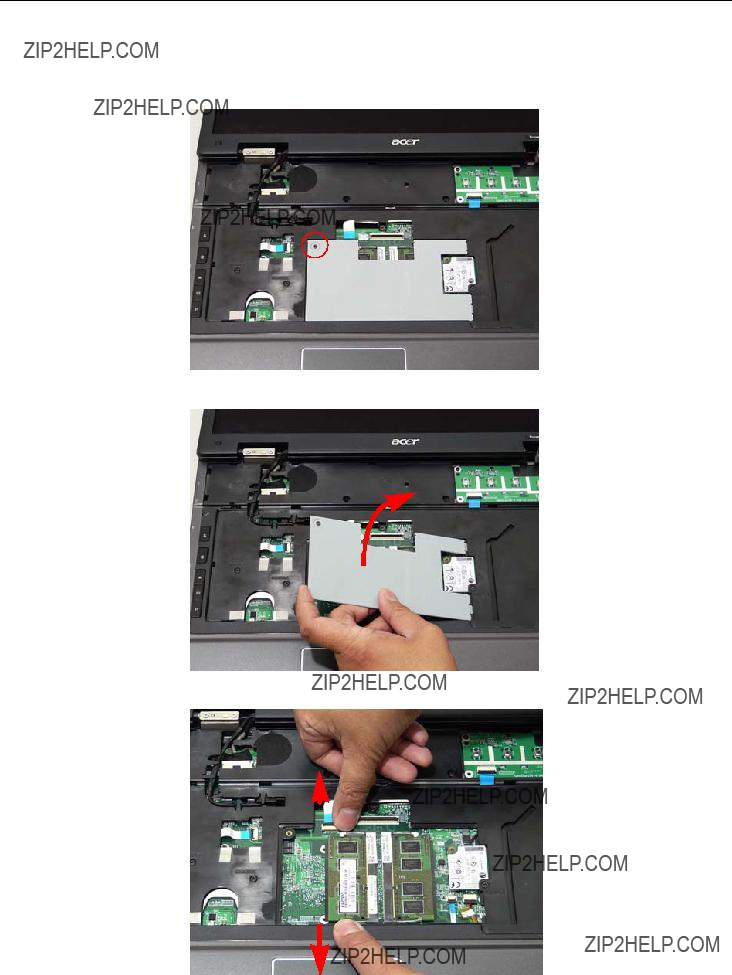
Removing the DIMM Modules
1.See ???Removing the Keyboard??? on page 64.
2.Loosen the captive screw on the keyboard plate.
3. Remove the plate to access the DIMM modules.
4. Push out the release latches on both sides of the DIMM socket to release the DIMM module.

5. Remove the DIMM module.
6. Repeat steps for the second DIMM module.

Removing the Antenna
1.Remove the Memory Cover. See ???Removing the Lower Covers??? on page 51.
2.Remove the HDD2 Cover. See ???Removing the Lower Covers??? on page 51.
3.Remove the WLAN Module. See ???Removing the WLAN Module??? on page 53.
4.Disconnect the Antenna Cables from the securing guides as shown.
5. Pull the cables completely through the housing.
6. While pushing the cables through the underside, pull them completely through the upper cover.

Removing the LCD Module
1.See ???Removing the Battery Pack??? on page 48.
2.See ???Removing the Lower Covers??? on page 51.
3.See ???Removing the Keyboard??? on page 64.
4.See ???Removing the Antenna??? on page 67.
5.Remove the two securing screws from the bottom of the chassis.
6. Turn the computer over. Disconnect the LCD cable from the top panel.
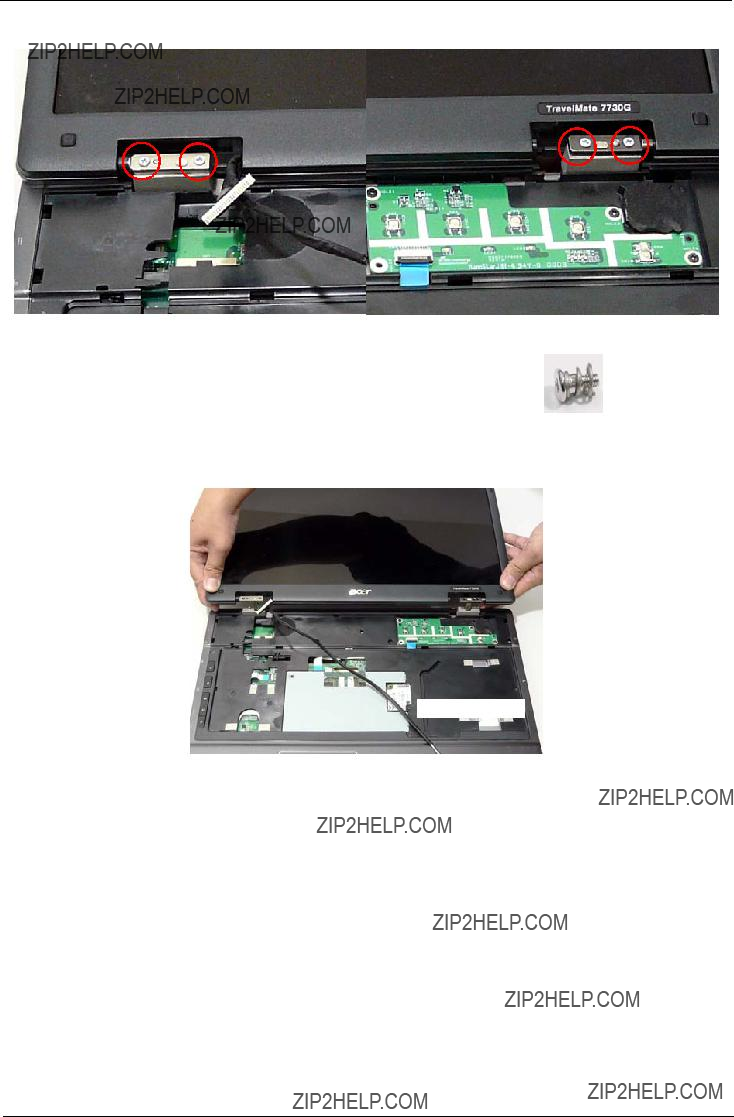
7. Remove the four securing screws (two on each side) from the LCD module.
8. Carefully remove the LCD module from the chassis.
IMPORTANT:Place the LCD module face up on a clean surface to prevent scratching or damage.
Antenna cable

Removing the Switch Board
1.See ???Removing the Upper Cover??? on page 71.
2.Remove the three securing screws.
3. Disconnect the FFC and remove the Switch Board from the upper cover.
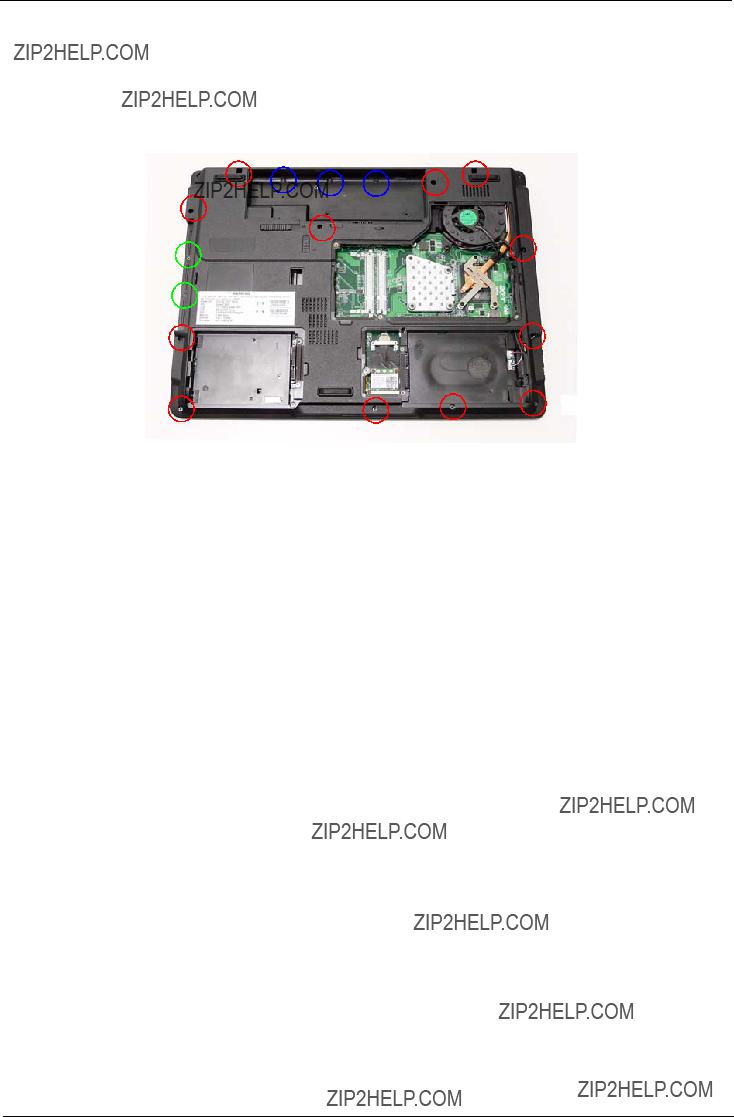
Removing the Upper Cover
1.See ???Removing the Battery Pack??? on page 48.
2.See ???Removing the LCD Module??? on page 68.
3.See ???Removing the Switch Board??? on page 70.
4.Turn the computer over. Remove the sixteen (16) screws on the bottom panel.

5. Turn the computer over. Remove the four screws on the top panel.
Red Callout
6. Disconnect the MIC and speaker cables and carefully pull through the HDD housing.

7. Pull the cables under and through the thermal module.
8. Turn the computer over, and disconnect the four cables from the mainboard as shown.
B
Replace with no DIMMs Image
A
C
D
NOTE: The image depicts installed DIMM modules. The DIMM modules must be removed before proceeding.

Release the securing latch and disconnect (A) as shown.
Release the securing latch and disconnect (B) as shown.
9. Remove the upper cover by lifting upward from the chassis, rear edge first.

Removing the Finger Print Reader
1.See ???Removing the Upper Cover??? on page 71.
2.Disconnect the touchpad to switch FFC.
3. Disconnect the switch to mainboard FFC.
4. Disconnect the finger print cable.

5. Remove the two securing screws from the Finger Print Reader board.
6. Using your fingers, gently lift the Finger Print Reader board from the Upper Cover.
Removing the Speaker Module
1.See ???Removing the Upper Cover??? on page 71.
2.Remove the two securing screws from the left speaker.

3. Disconnect the Mic cable.
4. Remove the five securing screws.
5. Remove the Speaker Modules as shown.

Removing the TouchPad
1.Remove the Upper Cover. See ???Removing the Upper Cover??? on page 71.
2.Remove the Speaker Module. See ???Removing the Speaker Module??? on page 76.
3.Remove the Finger Print Reader. See ???Removing the Finger Print Reader??? on page 75.
4.Disconnect the TouchPad FFC from the TouchPad board.
Take note of any items that may remain on the upper cover, and remove them. To replace the TouchPad, the upper cover module must be replaced.

Removing the Launch Board
1.See ???Removing the Upper Cover??? on page 71.
2.Lift the locking lever and disconnect the FFC.
3.Remove the three securing screws.
4. Remove the Launch Board from the upper cover.

5. Remove the Launch Board from the bracket.

Removing the Bluetooth Module
1.See ???Removing the Upper Cover??? on page 71.
2.Disconnect the Bluetooth cable connecting the Bluetooth module.
3. Lift the Bluetooth module away from the base.
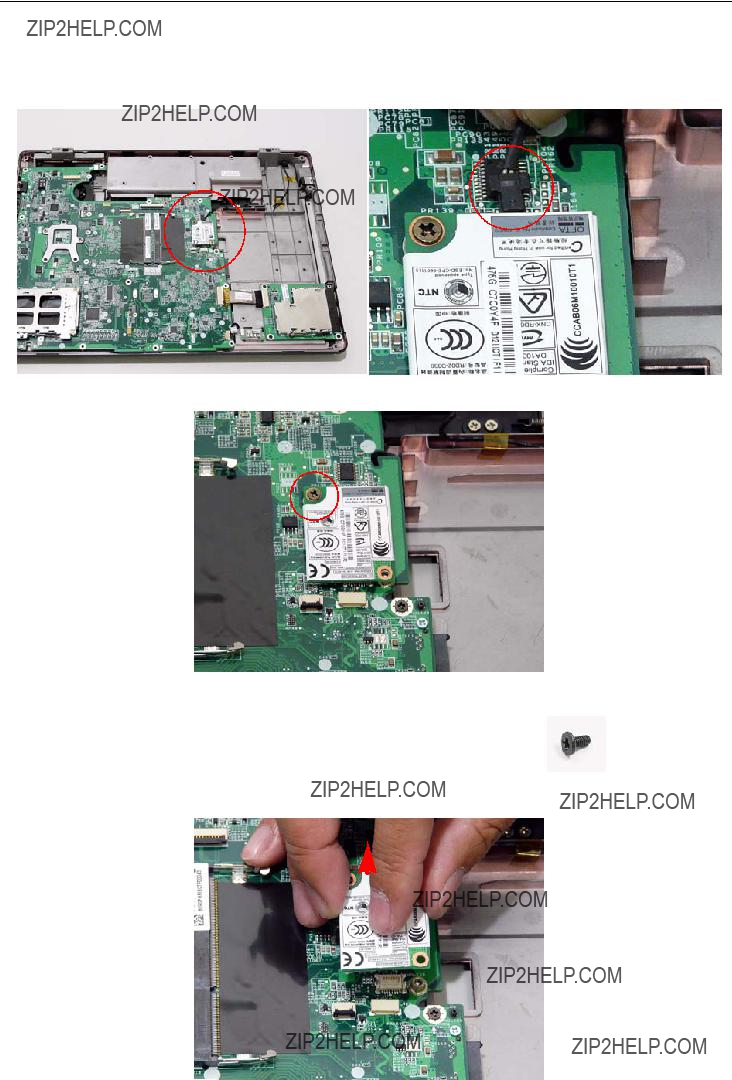
Removing the Modem Module
1.See ???Removing the Upper Cover??? on page 71.
2.Locate the modem module and disconnect the cable.
3. Remove the securing screw from the modem module.
4. Lift the module from the mainboard.

Removing the ExpressCard Module
1.See ???Removing the Upper Cover??? on page 71.
2.Disconnect the cable connecting the ExpressCard module.
3. Remove the three securing screws.
4. Lift the ExpressCard module away from the upper cover.

Removing the Mainboard
1.See ???Removing the Upper Cover??? on page 71.
2.See ???Removing the Modem Module??? on page 82.
3.Disconnect ExpressCard and Bluetooth cables attached to the mainboard.
4. Remove the two securing screws on the mainboard.

5. Remove the mainboard from the lower base.

Removing the CPU Fan
1.Remove the Mainboard. See ???Removing the Mainboard??? on page 84.
2.Loosen the three captive screws.
3. Disconnect the Fan cable from the mainboard.
4. Lift the Fan module clear of the mainboard.
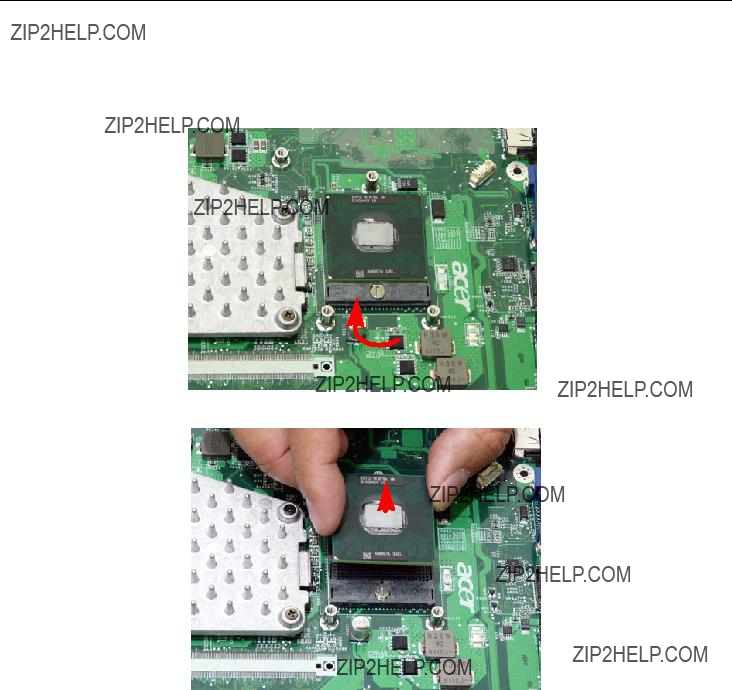
Removing the CPU
1.Remove the Mainboard. See ???Removing the Mainboard??? on page 84.
2.Take note of the indicators on the socket cam screw. Using a flat screwdriver, turn the CPU socket screw
k
3. Lift the CPU clear of the Mainboard.

LCD Module Disassembly Process
LCD Module Disassembly Flowchart
Remove LCD Panel from Main Unit before proceeding
Remove
LCD Bezel
Remove
LCD Assembly
LCD
Back
Assembly
Panel
Assembly
Screw List

Removing the LCD Bezel
1.Remove the LCD Module. See ???Removing the LCD Module??? on page 68.
2.Remove the six rubber covers and screws.
3.Starting from the inside edges, pry the inside of the bezel upwards from the panel. Continue moving left until the bezel is removed. If necessary, use a plastic pry to release the corners of the bezel.

4.Lift up the bezel and remove it from the LCD Module.

Removing the Inverter Board
1.Remove the LCD Bezel. See ???Removing the LCD Bezel??? on page 89.
2.Disconnect the left and right Inverter board cables as shown.
3.Lift the Inverter board clear of the LCD Module.

Removing the Camera Module
1.Remove the LCD Bezel. See ???Removing the LCD Bezel??? on page 89.
2.Disconnect the Camera Module cable as shown.
IMPORTANT:Be careful when using a sharp tool to remove the cable or camera module. The surface of the LCD panel can be easily scratched.
3. Remove the module from its securing pins and lift away from the bracket.

Removing the LCD Panel
1.Remove the LCD Bezel. See ???Removing the LCD Bezel??? on page 89.
2.Remove the nine securing screws from the LCD Panel.
IMPORTANT:The leftside screw holds the ground connector in place. Ensure that the ground is replaced during reassembly.
 Ground
Ground
 Ground
Ground
3. Lift the LCD Panel clear of the LCD Module.
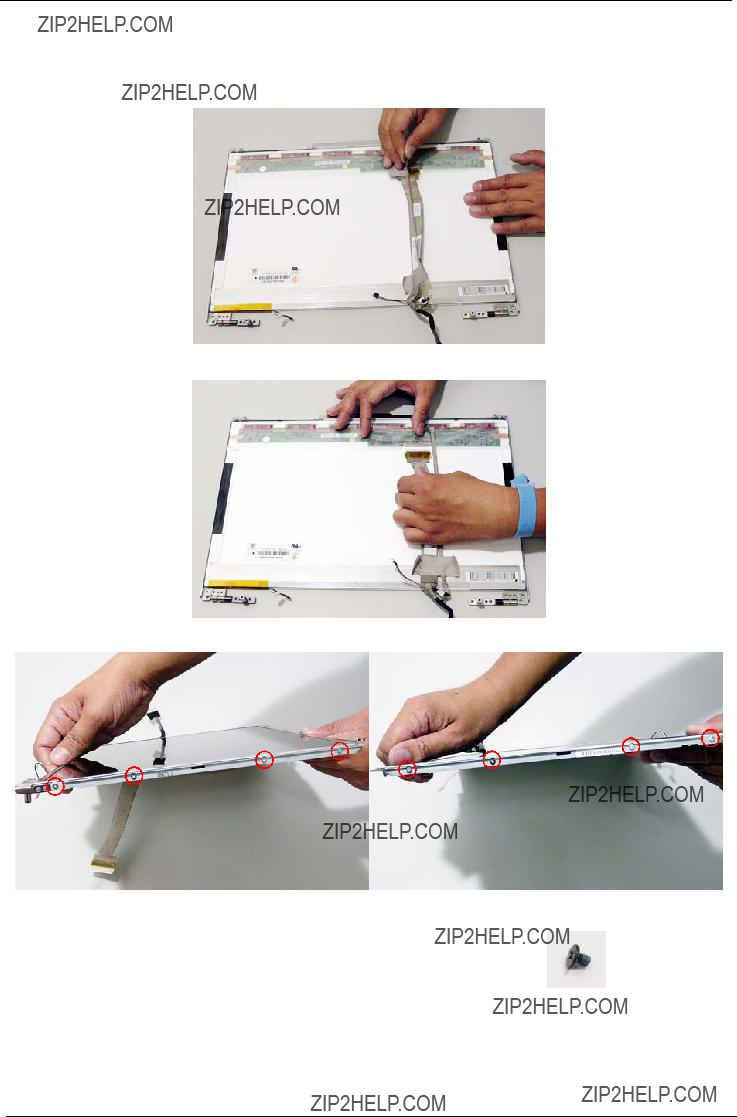
Removing the LCD Brackets and FPC Cable
1.Remove the LCD Panel. See ???Removing the LCD Panel??? on page 93.
2.Turn the LCD panel over to expose the rear. Remove the mylar strips securing the FPC cable.
3. Disconnect the cable from the panel and remove.
4. Remove the eight securing screws (four on each side) from the LCD Panel brackets.

5. Remove the two securing screws from the camera bracket (top of LCD Panel).
6. Remove the camera and LCD brackets by pulling away from the LCD Panel as shown.

LCD Module Reassembly Procedure
Replacing the LCD Panel
1. Align the LCD brackets and the camera bracket in place.
2. Replace the two securing screws on the camera bracket (top of LCD panel).
3. Replace the eight securing screws (four on each side) on the LCD Panel brackets.

4. Align the LCD Panel cable as shown. Conenct the LCD cable and press down to engage the adhesive pads.
5.Ensure that all cables are positioned out of the way, and place the LCD Panel in the back cover.
6.Replace the ground cable and secure with the screw.
 Ground
Ground
7.Secure the LCD module with the eight securing screws.
8.Align the Camera Module over the guide pins and insert it in place (adhesive side down). Secure by pressing down to insure cohesion.

9. Connect the Camera Module cable.
10. Insert the Inverter board in place. Press down to ensure cohesion.
11. Connect the left and right Inverter board cables as shown.

Replacing the LCD Bezel
1.Locate the bezel correctly and press down the edges until there are no gaps between the bezel and the LCD Module.
2.Starting from left to right, firmly press down to ensure the bezel is situated correctly (four locations on each side).
3. Replace the six screws and the rubber caps provided.

Main Module Reassembly Procedure
Replacing the CPU
1.Carefully turn the mainboard upside down (CPU side up), and insert the CPU into the CPU bracket as shown.
2.Using a plastic screw driver, lock the CPU in the socket as shown.
Replacing the CPU Fan Module
1. Align the Fan Module on the screw brackets.
2.Secure the 3 screws according to the following numbered order.
2
13
3. Connect the Fan cable to the Mainboard.

Replacing the Mainboard
1.Ensure that the Mainboard is face up (the Heatsink and CPU are not visible). Place the Mainboard in the chassis, rear edge first, and press down to install. Replace the two securing screws as shown.
NOTE: Make sure the I/O ports are positioned correctly through the lower cover, and the screw sockets are visible through the mainboard.
2. Replace the two securing screws on the mainboard.

3. Connect the ExpressCard and Bluetooth cables attached to the mainboard.

Replacing the Bluetooth Board
3. Connect the Bluetooth cable to the Bluetooth module.
Replacing the Modem Module
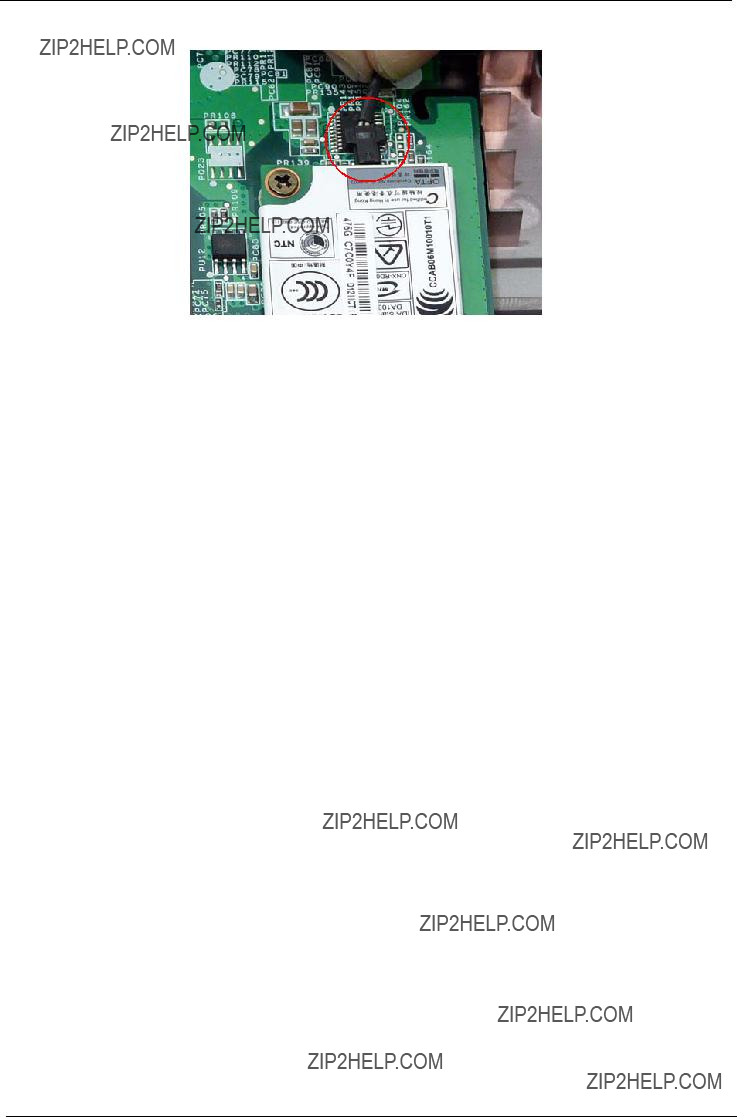
3. Connect the modem cable to the module.

Replacing the Finger Print Reader
1. Replace the Finger Print Reader board in the upper cover.
NOTE: Carefully insert the FFC cable ends fully into the connector. Take care to line up the cable square with the connector before securing the FFC connector latch.

Replacing the Launch Board
1. Replace the Launch Board in the bracket.
2. Replace the Launch Board on the upper cover.
3. Replace the three securing screws.
4.Line up the FFC square with the connector. Hold the cable in place and press lever down to secure.

Replacing the Speaker Module
1. Replace the speaker modules as shown.
3.Secure the speaker cable as shown with the adhesive tape.
2.Replace the five securing screws, three on the left module and two on the right module.
4. Replace the Microphone as shown.
5. Secure the microphone cable as shown with the adhesive tape.

Replacing the TouchPad
1. Connect the TouchPad cable to the TouchPad board.
IMPORTANT:The TouchPad cannot be removed individually. To replace the TouchPad, replace the entire Upper Cover.
Replacing the Upper Cover
1.Tilt the Upper cover and insert the back of the cover into place.
2.While holding the Upper Cover at an angle, insert the MIC cable through the lower base taking care to ensure that the cable is accessible from the bottom cover.
MIC Cable

3. Connect the four cables from the mainboard as shown in the following image.
B
A
C
D
4.Align (A) and secure by securing the FFC connector latch.
5.Align (B) and secure by securing the FFC connector latch.
6.Align (D) and secure by securing the FFC connector latch.
7.Connect (C) as shown.
NOTE: Carefully insert the FFC cable ends fully into the connector. Take care to line up the cable square with the connector before securing the FFC connector latch.

8. Insert the Antenna Cables completely through the upper cover.
9. Pull the cables through and locate them in the housing guides as shown in the following image.
10.Turn the computer over and locate the MIC/Speaker cables.
11.Insert the cables under the thermal module as shown.

12. Continue to insert the cables through the HDD2 housing and pull the cable taunt.
13. Locate the cables in the housing guides located by the CPU Fan module. 14. Connect the cables.
1
2
15. Replace the sixteen (16) screws as marked in the following image.

16. Turn the chassis over and replace the four securing screws.
Replacing the LCD Module
1. Align the LCD Module hinges with the alignment pins and gently set down.
 Alignment Pin
Alignment Pin
2. Replace the four securing screws (two on each side) on the LCD module.

3. Connect the LCD cable on the top panel.
4. Insert the Antenna Cables through the Upper Cover. Make sure they are accessible from the underside.
5. Secure the cables in place as shown.
6. Turn the computer over and pull the antenna cables until it is taunt.

7. Grasp the cable and insert it through the HDD2 housing.
Replacing the Switch Board
1.Replace the three securing screws.
2.Place the Switch Board in its location and replace the three screws.
3.Replace the FFC and ensure the cable is flush with the connector. Secure by locking the latch.
replace this picture. FFC must be disconnected.

Replacing the DIMM Modules
1.Insert the
2.Insert the
3. Replace the keyboard plate taking care to pay attention to the installation guides on the leftside of the plate.

4. Tighten the captive screw on the keyboard plate.
Replacing the Keyboard
1.Replace keyboard cable to the mainboard, and secure the locking latch.
Replacing the Switch Cover
1.Insert one side of the Switch Cover into the chassis.
2.Turn the keyboard over and place the front edge first in the mounting.
New Image needed
2.While holding the inserted side in place, grasp the Switch Cover in the middle and bend slightly to allow for the other side to be inserted.
3. Secure the Switch Cover in place by pressing on all sides until the Switch Cover clicks in place.

Replacing the Turbo RAM Module
Insert the Turbo RAM Module and ensure it is flush with the connector.

Replacing the WLAN Module
3. Connect the three antenna cables to the module.
Replacing the Hard Disk Drive Module

3. Replace the four screws securing the hard disk to 4. Replace the HDD holder. the carrier.
5.Place the HDD in the bay and slide into the connector. Ensure the HDD is secure before replacing the cover.
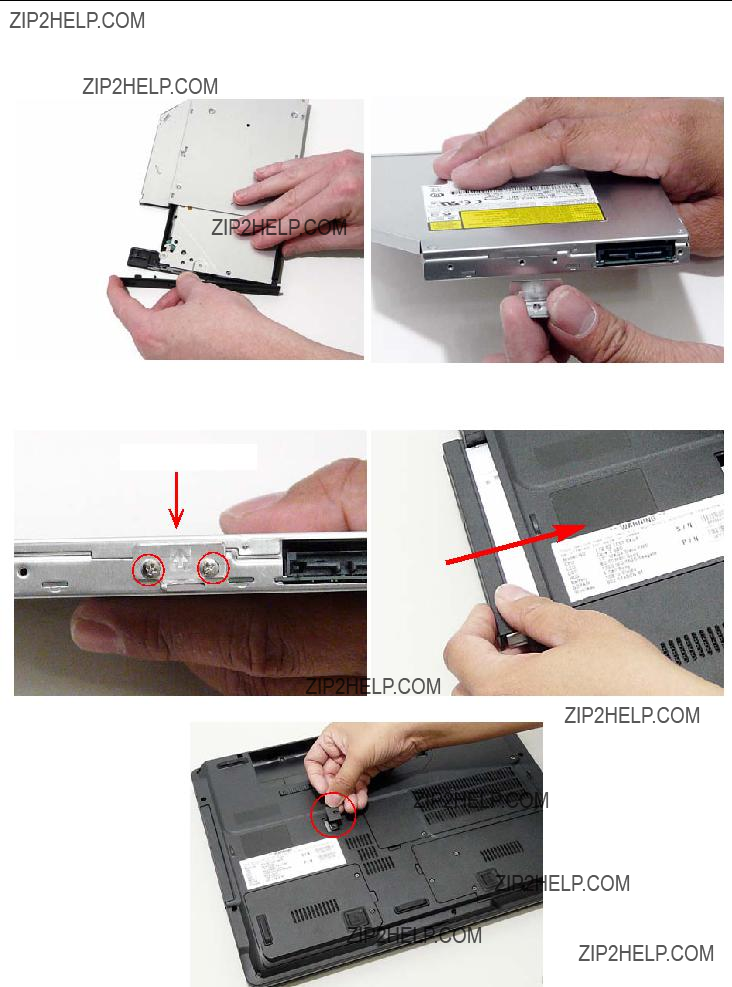
Replacing the ODD Module
3. Secure the bracket with the two screws.
IMPORTANT:Take note of the arrow on the bracket. The arrow designates the bottom of the ODD.
ODD Bottom
4.Slide Module in chassis and press until Module is flush with chassis.
5. Replace the ODD cap and secure with the single screw.

Replacing the Lower Covers

Replacing the Express and SD Card Trays
1.Insert the Express Card and push into the slot until flush with the chassis cover.
2.Insert the SD Card and push into the slot until flush with the chassis cover.

Chapter 4
Troubleshooting
Common Problems
Use the following procedure as a guide for computer problems.
NOTE: The diagnostic tests are intended to test only Acer products.
1.Obtain the failing symptoms in as much detail as possible.
2.Verify the symptoms by attempting to
3.Use the following table with the verified symptom to determine which page to go to.
4.If the Issue is still not resolved, see ???Online Support Information??? on page 173.

Power On Issue
If the system doesn???t power on, perform the following actions one at a time to correct the problem. Do not replace a
Computer Shutsdown Intermittently
If the system powers off at intervals, perform the following actions one at a time to correct the problem.
1.Check the power cable is properly connected to the computer and the electrical outlet.
2.Remove any extension cables between the computer and the outlet.
3.Remove any surge protectors between the computer and the electrical outlet. Plug the computer directly into a known good electrical outlet.
4.Disconnect the power and open the casing to check the Thermal Unit (see ???Thermal Unit Failure??? on page 138) and fan airways are free of obstructions.
5.Disable the power management settings in the BIOS to ensure they are not the cause of the problem (see ???Boot??? on page 36).
6.Remove all external and
7.Remove any recently installed software.
8.If the Issue is still not resolved, see ???Online Support Information??? on page 173.
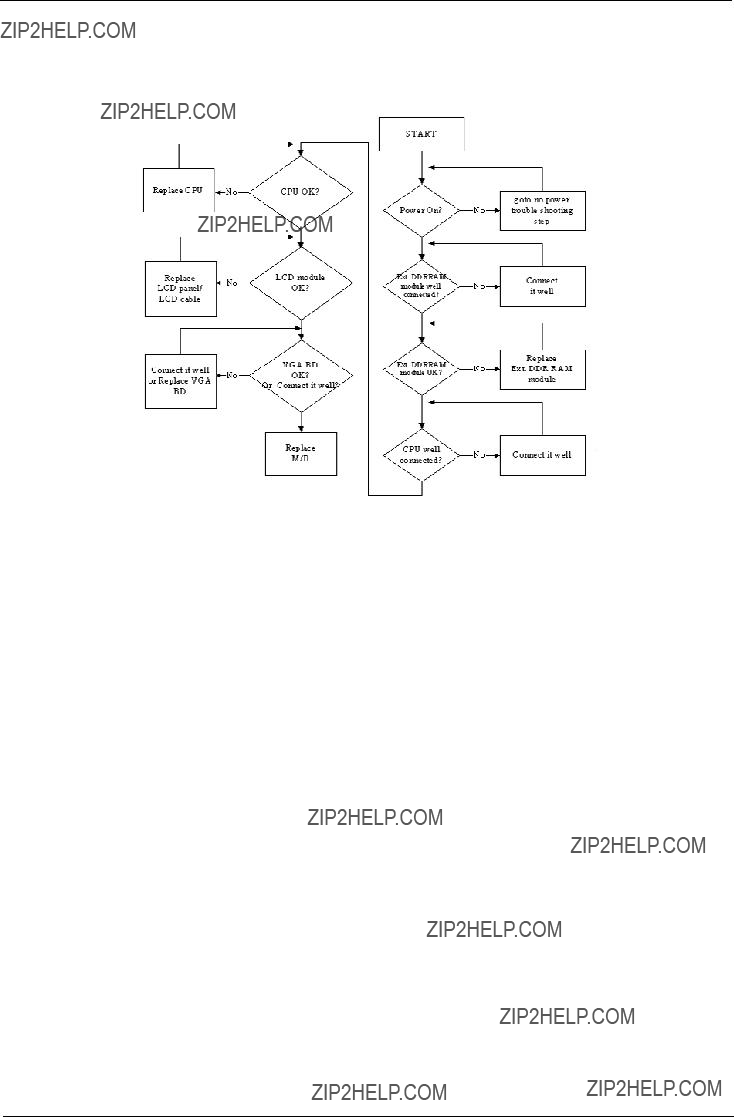
No Display Issue
If the Display doesn???t work, perform the following actions one at a time to correct the problem. Do not replace a
No POST or Video
If the POST or video doesn???t display, perform the following actions one at a time to correct the problem.
1.Make sure that the internal display is selected. On this notebook model, switching between the internal display and the external display is done by pressing Fn+F5. Reference Product pages for specific model procedures.
2.Make sure the computer has power by checking at least one of the following occurs:
???Fans start up
???Status LEDs light up
If there is no power, see ???Power On Issue??? on page 124.
3.Drain any stored power by removing the power cable and battery and holding down the power button for 10 seconds. Reconnect the power and reboot the computer.
4.Connect an external monitor to the computer and switch between the internal display and the external display is by pressing Fn+F5 (on this model).
If the POST or video appears on the external display, see ???LCD Failure??? on page 127.
5.Disconnect power and all external devices including port replicators or docking stations. Remove any memory cards and CD/DVD discs. Restart the computer.
If the computer boots correctly, add the devices one by one until the failure point is discovered.
6.Reseat the memory modules.
7.Remove the drives (see ???Disassembly Process??? on page 46).
8.If the Issue is still not resolved, see ???Online Support Information??? on page 173.

Abnormal Video Display
If video displays abnormally, perform the following actions one at a time to correct the problem.
1.Reboot the computer.
2.If permanent vertical/horizontal lines or dark spots display in the same location, the LCD is faulty and should be replaced. See ???Disassembly Process??? on page 46.
3.If extensive pixel damage is present (different colored spots in the same locations on the screen), the LCD is faulty and should be replaced. See ???Disassembly Process??? on page 46.
4.Adjust the brightness to its highest level. See the User Manual for instructions on adjusting settings. NOTE: Ensure that the computer is not running on battery alone as this may reduce display brightness.
If the display is too dim at the highest brightness setting, the LCD is faulty and should be replaced. See ???Disassembly Process??? on page 46.
5.Check the display resolution is correctly configured:
a.Minimize or close all Windows.
b.If display size is only abnormal in an application, check the view settings and control/mouse wheel zoom feature in the application.
c.If desktop display resolution is not normal,
Personalize?? Display Settings.
d.Click and drag the Resolution slider to the desired resolution.
e.Click Apply and check the display. Readjust if necessary.
6.Roll back the video driver to the previous version if updated.
7.Remove and reinstall the video driver.
8.Check the Device Manager to determine that:
???The device is properly installed. There are no red Xs or yellow exclamation marks.
???There are no device conflicts.
???No hardware is listed under Other Devices.
9.If the Issue is still not resolved, see ???Online Support Information??? on page 173.
10.Run the Windows Memory Diagnostic from the operating system DVD and follow the onscreen prompts.
11.If the Issue is still not resolved, see ???Online Support Information??? on page 173.
Random Loss of BIOS Settings
If the computer is experiencing intermittent loss of BIOS information, perform the following actions one at a time to correct the problem.
1.If the computer is more than one year old, replace the CMOS battery.
2.Run a complete virus scan using
3.If the computer is experiencing HDD or ODD BIOS information loss, disconnect and reconnect the power and data cables between devices.
If the BIOS settings are still lost, replace the cables.
4.If HDD information is missing from the BIOS, the drive may be defective and should be replaced.
5.Replace the Motherboard.
6.If the Issue is still not resolved, see ???Online Support Information??? on page 173.

LCD Failure
If the LCD fails, perform the following actions one at a time to correct the problem. Do not replace a non- defective FRUs:
If the

TouchPad Failure
If the TouchPad doesn???t work, perform the following actions one at a time to correct the problem. Do not replace a
Internal Speaker Failure
If the internal Speakers fail, perform the following actions one at a time to correct the problem. Do not replace a

Sound Problems
If sound problems are experienced, perform the following actions one at a time to correct the problem.
1.Reboot the computer.
2.Navigate to Start?? Control Panel?? System and Maintenance?? System?? Device Manager. Check the Device Manager to determine that:
???The device is properly installed.
???There are no red Xs or yellow exclamation marks.
???There are no device conflicts.
???No hardware is listed under Other Devices.
3.Roll back the audio driver to the previous version, if updated recently.
4.Remove and reinstall the audio driver.
5.Ensure that all volume controls are set mid range:
a.Click the volume icon on the taskbar and drag the slider to 50. Ensure that the volume is not muted.
b.Click Mixer to verify that other audio applications are set to 50 and not muted.
6.Navigate to Start?? Control Panel?? Hardware and Sound?? Sound. Ensure that Speakers are selected as the default audio device (green check mark).
NOTE: If Speakers does not show,
7.Select Speakers and click Configure to start Speaker Setup. Follow the onscreen prompts to configure the speakers.
8.Remove and recently installed hardware or software.
9.Restore system and file settings from a known good date using System Restore.
If the issue is not fixed, repeat the preceding steps and select an earlier time and date.
10.Reinstall the Operating System.
11.If the Issue is still not resolved, see ???Online Support Information??? on page 173.

Internal Microphone Failure
If the internal Microphone fails, perform the following actions one at a time to correct the problem. Do not replace a
Microphone Problems
If internal or external Microphones do no operate correctly, perform the following actions one at a time to correct the problem.
1.Check that the microphone is enabled. Navigate to Start?? Control Panel?? Hardware and Sound?? Sound and select the Recording tab.
2.
3.The microphone appears on the Recording tab.
4.
5.Select the microphone then click Properties. Select the Levels tab.
6.Increase the volume to the maximum setting and click OK.
7.Test the microphone hardware:
a.Select the microphone and click Configure.
b.Select Set up microphone.
c.Select the microphone type from the list and click Next.
d.Follow the onscreen prompts to complete the test.
8.If the Issue is still not resolved, see ???Online Support Information??? on page 173.

HDD Not Operating Correctly
If the HDD does not operate correctly, perform the following actions one at a time to correct the problem.
1.Disconnect all external devices.
2.Run a complete virus scan using
3.Run the Windows Vista Startup Repair Utility:
a.insert the Windows Vista Operating System DVD in the ODD and restart the computer.
b.When prompted, press any key to start to the operating system DVD.
c.The Install Windows screen displays. Click Next.
d.Select Repair your computer.
e.The System Recovery Options screen displays. Click Next.
f.Select the appropriate operating system, and click Next.
NOTE: Click Load Drivers if controller drives are required.
g.Select Startup Repair.
h.Startup Repair attempts to locate and resolve issues with the computer.
i.When complete, click Finish.
If an issue is discovered, follow the onscreen information to resolve the problem.
4.Run the Windows Memory Diagnostic Tool. For more information see Windows Help and Support.
5.Restart the computer and press F2 to enter the BIOS Utility. Check the BIOS settings are correct and that CD/DVD drive is set as the first boot device on the Boot menu.
6.Ensure all cables and jumpers on the HDD and ODD are set correctly.
7.Remove any recently added hardware and associated software.
8.Run the Windows Disk Defragmenter. For more information see Windows Help and Support.
9.Run Windows Check Disk by entering chkdsk /r from a command prompt. For more information see Windows Help and Support.
10.Restore system and file settings from a known good date using System Restore.
If the issue is not fixed, repeat the preceding steps and select an earlier time and date.
11.Replace the HDD. See ???Disassembly Process??? on page 46.

ODD Failure
If the ODD fails, perform the following actions one at a time to correct the problem. Do not replace a non- defective FRUs:
ODD Not Operating Correctly
If the ODD exhibits any of the following symptoms it may be faulty:
???Audio CDs do not play when loaded
???DVDs do not play when loaded
???Blank discs do not burn correctly
???DVD or CD play breaks up or jumps
???Optical drive not found or not active:
???Not shown in My Computer or the BIOS setup
???LED does not flash when the computer starts up
???The tray does not eject
???Access failure screen displays
???The ODD is noisy
Perform the following general solutions one at a time to correct the problem.
1.Reboot the computer and retry the operation.
2.Try an alternate disc.
3.Navigate to Start?? Computer. Check that the ODD device is displayed in the Devices with Removable Storage panel.
4.Navigate to Start?? Control Panel?? System and Maintenance?? System?? Device Manager.

a.
b.
c.Check that there are no yellow exclamation marks against the items in lDE ATA/ATAPI controllers. If a device has an exclamation mark,
d.Check that there are no yellow exclamation marks against the items in
e.If the exclamation marker is not removed from the item in the lists, try removing any recently installed software and retrying the operation.
Discs Do Not Play
If discs do not play when inserted in the drive, perform the following actions one at a time to correct the problem.
1.Check that the disc is correctly seated in the drive tray and that the label on the disc is visible.
2.Check that the media is clean and scratch free.
3.Try an alternate disc in the drive.
4.Ensure that AutoPlay is enabled:
a.Navigate to Start?? Control Panel?? Hardware and Sound?? AutoPlay.
b.Select Use AutoPlay for all media and devices.
c.In the Audio CD and DVD Movie fields, select the desired player from the drop down menu.
5.Check that the Regional Code is correct for the selected media:
IMPORTANT:Region can only be changed a limited number of times. After Changes remaining reaches zero, the region cannot be changed even Windows is reinstalled or the drive is moved to another computer.
a.Navigate to Start?? Control Panel?? System and Maintenance?? System?? Device Manager.
b.
c.
d.Select the region suitable for the media inserted in the drive.
Discs Do Not Burn Properly
If discs can not be burned, perform the following actions one at a time to correct the problem.
1.Ensure that the default drive is record enabled:
a.Navigate to Start?? Computer and
b.Select the Recording tab. In the Desktop disc recording panel, select the writable ODD from the drop down list.
c.Click OK.
2.Ensure that the software used for burning discs is the factory default. If using different software, refer to the software's user manual.
Playback is Choppy
If playback is choppy or jumps, perform the following actions one at a time to correct the problem.
1.Check that system resources are not running low:
a.Try closing some applications.
b.Reboot and try the operation again.
2.Check that the ODD controller transfer mode is set to DMA:
a.Navigate to Start?? Control Panel?? System and Maintenance?? System?? Device Manager.

b.
c.Click Properties and select the Advanced Settings tab. Ensure that the Enable DMA box is checked and click OK.
d.Repeat for the other ATA Devices shown if applicable.
Drive Not Detected
If Windows cannot detect the drive, perform the following actions one at a time to correct the problem.
1.Restart the computer and press F2 to enter the BIOS Utility.
2.Check that the drive is detected in the ATAPI Model Name field on the Information page.
NOTE: Check that the entry is identical to one of the ODDs specified in ???Hardware Specifications and Configurations??? on page 18.
3.Turn off the power and remove the cover to inspect the connections to the ODD. See ???Disassembly Process??? on page 46.
a.Check for broken connectors on the drive, motherboard, and cables.
b.Check for bent or broken pins on the drive, motherboard, and cable connections.
c.Try an alternate cable, if available. If the drive works with the new cable, the original cable should be replaced.
4.Reseat the drive ensuring and all cables are connected correctly.
5.Replace the ODD. See ???Disassembly Process??? on page 46.
Drive Read Failure
If discs cannot be read when inserted in the drive, perform the following actions one at a time to correct the problem.
1.Remove and clean the failed disc.
2.Retry reading the CD or DVD.
d.Test the drive using other discs.
e.Play a DVD movie
f.Listen to a music CD
If the ODD works properly with alternate discs, the original disc is probably defective and should be replaced.
3.Turn off the power and remove the cover to inspect the connections to the ODD. See ???Disassembly Process??? on page 46.
a.Check for broken connectors on the drive, motherboard, and cables.
b.Check for bent or broken pins on the drive, motherboard, and cable connections.
c.Try an alternate cable, if available. If the drive works with the new cable, the original cable should be replaced.
4.Replace the ODD. See ???Disassembly Process??? on page 46.

USB Failure (Rightside)
If the rightside USB port fails, perform the following actions one at a time to correct the problem. Do not replace a
Modem Function Failure
If the internal Modem fails, perform the following actions one at a time to correct the problem. Do not replace a

Wireless Function Failure
If the WLAN fails, perform the following actions one at a time to correct the problem. Do not replace a non- defective FRUs:
EasyTouch Button Failure
If the Acer EasyTouch buttons fail, perform the following actions one at a time to correct the problem. Do not replace a

MediaTouch Button Failure
If the Acer MediaTouch buttons fail, perform the following actions one at a time to correct the problem. Do not replace a
Fingerprint Reader Failure
If the Fingerprint Reader fails, perform the following actions one at a time to correct the problem. Do not replace a

Thermal Unit Failure
If the Thermal Unit fails, perform the following actions one at a time to correct the problem. Do not replace a
HDTV Switch Failure
If the HDTV Switch fails, perform the following actions one at a time to correct the problem. Do not replace a

External Mouse Failure
If an external Mouse fails, perform the following actions one at a time to correct the problem.
1.Try an alternative mouse.
2.If the mouse uses a wireless connection, insert new batteries and confirm there is a good connection. See the mouse user manual.
3.If the mouse uses a USB connection, try an alternate USB port.
4.Try an alternative program to verify mouse operation. Reinstall the program experiencing mouse failure.
5.Restart the computer.
6.Remove any recently added hardware and associated software.
7.Remove any recently added software and reboot.
8.Restore system and file settings from a known good date using System Restore.
If the issue is not fixed, repeat the preceding steps and select an earlier time and date.
9.Run the Event Viewer to check the events log for errors. For more information see Windows Help and Support.
10.Roll back the mouse driver to the previous version if updated recently.
11.Remove and reinstall the mouse driver.
12.Check the Device Manager to determine that:
???The device is properly installed. There are no red Xs or yellow exclamation marks.
???There are no device conflicts.
???No hardware is listed under Other Devices.
13.If the Issue is still not resolved, see ???Online Support Information??? on page 173.
Other Failures
If the CRT Switch, Dock, LAN Port, external MIC or Speakers, PCI Express Card,
1.Check Drive whether is OK.
2.Check Test Fixture is ok.
3.Swap M/B to Try.

Intermittent Problems
Intermittent system hang problems can be caused by a variety of reasons that have nothing to do with a hardware defect, such as: cosmic radiation, electrostatic discharge, or software errors. FRU replacement should be considered only when a recurring problem exists.
When analyzing an intermittent problem, do the following:
1.Run the advanced diagnostic test for the system board in loop mode at least 10 times.
2.If no error is detected, do not replace any FRU.
3.If any error is detected, replace the FRU. Rerun the test to verify that there are no more errors.
Undetermined Problems
The diagnostic problems does not identify which adapter or device failed, which installed devices are incorrect, whether a short circuit is suspected, or whether the system is inoperative.
Follow these procedures to isolate the failing FRU (do not isolate
NOTE: Verify that the power supply being used at the time of the failure is operating correctly. (See ???Power On Issue??? on page 124.):
1.
2.Visually check them for damage. If any problems are found, replace the FRU.
3.Remove or disconnect all of the following devices:
???
???Printer, mouse, and other external devices
???Battery pack
???Hard disk drive
???DIMM
???
???PC Cards
4.
5.Determine if the problem has changed.
6.If the problem does not recur, reconnect the removed devices one at a time until you find the failing FRU.
7.If the problem remains, replace the following FRU one at a time. Do not replace a
???System board
???LCD assembly

POST Codes Tables
These tables describe the chipset and core POST codes, functions, phases, and components for the POST.
Chipset POST Codes
The following table details the chipset POST codes and functions used in the POST.



* If the BIOS detects error 2C, 2E, or 30 (base 512K RAM error), it displays an additional

Chapter 5
Jumper and Connector Locations
Top View

Bottom View

Clearing Password Check and BIOS Recovery
This section provide you the standard operating procedures of clearing password and BIOS recovery for TravelMate 7530/7230. TravelMate 7530/7230s provide one Hardware Open Gap on main board for clearing password check, and one Hotkey for enabling BIOS Recovery.
Clearing Password Check
Hardware Open Gap Description
Steps for Clearing BIOS Password Check
If users set BIOS Password (Supervisor Password and/or User Password) for a security reason, BIOS will ask the password during systems POST or when systems enter to BIOS Setup menu. However, once it is necessary to bypass the password check, users need to short the HW Gap to clear the password by the following steps:
???Power Off a system, and remove HDD, AC and Battery from the machine.
???Open the back cover of the machine, and find out the HW Gap on M/B as picture.
???Use an electric conductivity tool to short the two points of the HW Gap.
???Plug in AC, keep the short condition on the HW Gap, and press Power Button to power on the system till BIOS POST finish. Then remove the tool from the HW Gap.
???Restart system. Press F2 key to enter BIOS Setup menu.
???If there is no Password request, BIOS Password is cleared. Otherwise, please follow the steps and try again.
NOTE: The steps are only for clearing BIOS Password (Supervisor Password and User Password).

BIOS Recovery by Crisis Disk
BIOS Recovery Boot Block:
BIOS Recovery Boot Block is a special block of BIOS. It is used to boot up the system with minimum BIOS initialization. Users can enable this feature to restore the BIOS firmware to a successful one once the previous BIOS flashing process failed.
BIOS Recovery Hotkey:
The system provides a function hotkey: Fn+Esc, for enable BIOS Recovery process when system is powered on during BIOS POST. To use this function, it is strongly recommended to have the AC adapter and Battery present. If this function is enabled, the system will force the BIOS to enter a special BIOS block, called Boot Block.
Steps for BIOS Recovery from USB Storage:
Before doing this, prepare the Crisis USB key. The Crisis USB key could be made by executing the Crisis Disk program in another system with Windows XP OS.
Follow the steps below:
1.Save ROM file (file name: JAL90x64.fd) to the root directory of USB storage.
2.Plug USB storage into USB port.
3.Press Fn + ESC button then plug in AC. The Power button flashes once.
4.Press Power button to initiate system CRISIS mode.
When CRISIS is complete, the system auto restarts with a workable BIOS.
5.Update the latest version BIOS for this machine by regular BIOS flashing process.
Chapter 6
FRU (Field Replaceable Unit) List
This chapter gives you the FRU (Field Replaceable Unit) listing in global configurations of TravelMate 7530/7230. Refer to this chapter whenever ordering for parts to repair or for RMA (Return Merchandise Authorization).
Please note that WHEN ORDERING FRU PARTS, you should check the most
NOTE: To scrap or to return the defective parts, you should follow the local government ordinance or regulations on how to dispose it properly, or follow the rules set by your regional Acer office on how to return it.
TravelMate 7530/7230 Exploded Diagrams
Upper/ Lower Cover
LCD Panel
TravelMate 7530/7230 FRU List

Appendix A
Model Definition and Configuration
TravelMate 7530/7230 Series

Appendix B
Test Compatible Components
This computer???s compatibility is tested and verified by Acer???s internal testing department. All of its system functions are tested under Windows?? XP Home, Windows?? XP Pro environment.
Refer to the following lists for components, adapter cards, and peripherals which have passed these tests. Regarding configuration, combination and test procedures, please refer to the TravelMate 7530/7230 series Compatibility Test Report released by the Acer Mobile System Testing Department.

Microsoft?? Windows?? Vista Environment Test





Appendix C
Online Support Information
This section describes online technical support services available to help you repair your Acer Systems.
If you are a distributor, dealer, ASP or TPM, please refer your technical queries to your local Acer branch office. Acer Branch Offices and Regional Business Units may access our website. However some information sources will require a user i.d. and password. These can be obtained directly from Acer CSD Taiwan.
Acer's Website offers you convenient and valuable support resources whenever you need them.
In the Technical Information section you can download information on all of Acer's Notebook, Desktop and Server models including:
???Service guides for all models
???User's manuals
???Training materials
???Bios updates
???Software utilities
???Spare parts lists
???TABs (Technical Announcement Bulletin)
For these purposes, we have included an Acrobat File to facilitate the
Also contained on this website are:
???Detailed information on Acer's International Traveler's Warranty (ITW)
???Returned material authorization procedures
???An overview of all the support services we offer, accompanied by a list of telephone, fax and email contacts for all your technical queries.
We are always looking for ways to optimize and improve our services, so if you have any suggestions or comments, please do not hesitate to communicate these to us.


Index
A
AFLASH Utility 40
B
Battery Pack 48
BIOS
BIOS Utility
Onboard Device Configuration 34 Power 36, 37
Save and Exit 39 Security 33 System Security 39
Bluetooth module 81 Board Layout
Top View 145 brightness
hotkeys 15
C
Camera Module 92 caps lock
on indicator 10 Chipset POST Codes 141 Common Problems 124 computer
D
DIMM Module 65 Display 4 display
hotkeys 15
E
EasyTouch Failure 136
Euro 15
ExpressCard Module 83
External Module Disassembly
Flowchart 47
F
Features 1
Fingerprint Reader Failure 137
Flash Utility 40
FPC Cable 94
FRU (Field Replaceable Unit) List 149
H
Hard Disk Drive1 Module 54 Hard Disk Drive2 Module 56 HDTV Switch Failure 138 Hibernation mode
I
Indicators 10
Intermittent Problems 140 Internal Microphone Failure 130 Internal Speaker Failure 128 inverter board 91
J
Jumper and Connector Locations 145
Top View 145
K
Keyboard 64
Keyboard Failure 127
L
Launch Board 79
LCD Bezel 89
LCD Brackets 94
LCD Failure 127
175

LCD Module Disassembly Flowchart 88
M
Main Unit Disassembly
Flowchart 60 Mainboard 84 media access
on indicator 10 MediaTouch Button Failure 137 Memory Check 124
Model Definition 166
Modem Failure 135
Modem Module 82
N
No Display Issue 125 Notebook Manager
hotkey 15 num lock
on indicator 10
O
ODD Failure 132
Online Support Information 173 optical drive module 58
P
Panel 5
PC Card 10
POST Codes Chipset 141
Power On Failure 124
S
speakers hotkey 15
System
Block Diagram 4
T
Test Compatible Components 167 Thermal Unit Failure 138
hotkey 15 TouchPad Failure 128 Troubleshooting
EasyTouch Buttons 136
Fingerprint Reader 137 HDTV Switch 138 Internal Microphone 130 Internal Speakers 128 LCD Failure 127
MediTouch Buttons 137 Modem 135
Other Failures 139 Power On 124
Thermal Unit 138
Turbo RAM module 52
U
Undetermined Problems 140 USB Failure (Rightside) 135 utility
BIOS
W
Windows 2000 Environment Test 168
Wireless Function Failure 136
WLAN Board 53
176